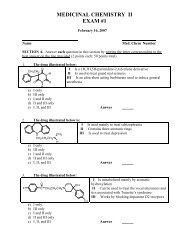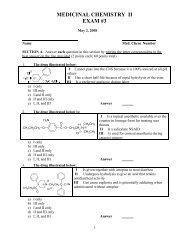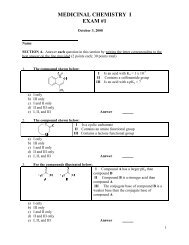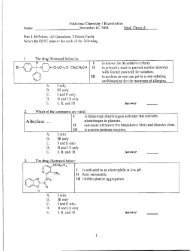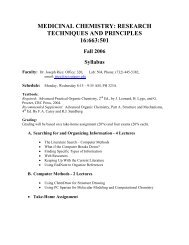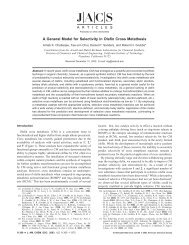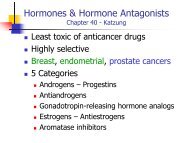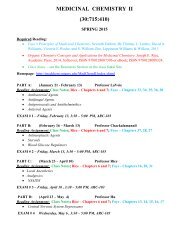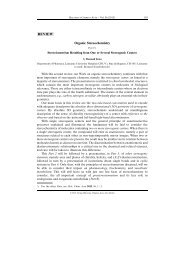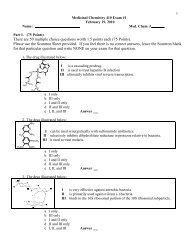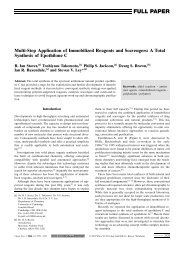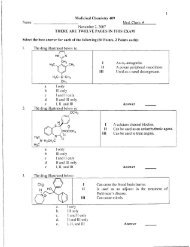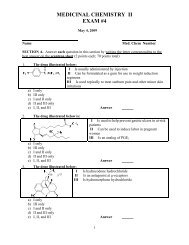Baldwin's Rules - Department of Medicinal Chemistry
Baldwin's Rules - Department of Medicinal Chemistry
Baldwin's Rules - Department of Medicinal Chemistry
Create successful ePaper yourself
Turn your PDF publications into a flip-book with our unique Google optimized e-Paper software.
Chemical Reviews REVIEW<br />
Figure 18. Reactant SOMO (left) and transition state geometries for 5-exo-dig (center) and 6-endo-dig (right) cyclizations <strong>of</strong> the 1,3-hexadien-5-yn-1yl<br />
radical. (CASSCF/6-31G(d)). Reproduced with permission from refs 135 and 147. Copyright 2005 and 2000 American Chemical Society.<br />
RCCSD(T)) calculations and found that the 5-exo activation<br />
barrier is only 1.4 kcal/mol lower than the 6-endo barrier (at<br />
the ZPVE-corrected RCCSD(T)6-311+G(3df,2p)//CASSCF/6-<br />
31G(d) level): a noticeable leveling in comparison to the difference<br />
between the respective digonal cyclizations <strong>of</strong> motifs B and C. 148<br />
Even still, the authors suggested that the lowest energy pathway for<br />
the formation <strong>of</strong> phenyl radical involves the rearrangement <strong>of</strong> the<br />
5-exo product via bicyclo[3.1.0]hex-3,5-dien-2-yl radical intermediate<br />
instead <strong>of</strong> direct 6-endo cyclization.<br />
The difference between the reaction energies <strong>of</strong> 5-exo and<br />
6-endo cyclizations is close to the difference in the stabilities <strong>of</strong><br />
benzene and fulvene. Interestingly, the incipient C 333 C bonds in<br />
the fully conjugated radicals are 0.3 0.6 Å shorter than in<br />
radicals with a saturated bridge. This trend, along with the high<br />
exothermicities, accounts for very early transition states for motif<br />
C digonal cyclizations (Figure 18). 135<br />
The majority <strong>of</strong> the literature examples agree with the<br />
calculated intrinsic 5-exo preference for the addition <strong>of</strong> vinyl<br />
radicals to triple bonds in conjugated systems. For example,<br />
K€onig, Schreiner and co-workers 149 reported an example <strong>of</strong> the<br />
5-exo-dig cyclization <strong>of</strong> an enediyne promoted by TEMPO<br />
(2,2,5,5-tetramethyl-4-piperidin-1-oxyl) radical (Scheme 40).<br />
Alabugin and co-workers found that Bu3Sn-initiated cyclizations<br />
<strong>of</strong> diaryl substituted enediynes proceed through the same<br />
pathway but with considerably improved yields, 150 thus providing<br />
a convenient synthetic approach to substituted fulvenes<br />
and indenes (Scheme 40). 151 Schmittel et al. found that triplet<br />
diradicals formed photochemically from enyne-carbodiimides<br />
(Scheme 40) and enyne-ketenimines undergo exclusively<br />
5-exo-dig cyclization. 152 Similar to the examples discussed previously<br />
(Scheme 39), aryl radicals (made by abstraction <strong>of</strong> a<br />
bromine atom) also close regioselectively in a 5-exo-dig fashion<br />
in conjugated systems. 153<br />
However, this “intrinsic preference” is not absolute and<br />
aromaticity-driven 6-endo cyclizations in conjugated systems<br />
can compete with the 5-exo pathway. 154 For example, Anthony<br />
and co-workers 153,155 reported that initial 5-exo-dig closure is<br />
followed by a surprisingly efficient 6-endo cyclizations in several<br />
constrained enediyne systems (Scheme 41). Matzger et al. 156<br />
also described thermal cycloaromatization <strong>of</strong> tri- and tetraynes<br />
where, following the 5-exo-dig closure dicussed above (Scheme 40),<br />
formation <strong>of</strong> the final product may potentially include, among other<br />
possibities, a selective 6-endo-dig closure (Scheme 41).<br />
Scheme 40. Regioselective 5-exo-dig Cyclizations in Conjugated<br />
Systems<br />
Scheme 41. Selective 6-endo-dig Cyclizations<br />
Moreover, in many cases, the ratio <strong>of</strong> 5-exo- and 6-endo-dig<br />
products is sensitive to the substitution pattern, for example, in<br />
the cyclizations <strong>of</strong> R-Bu3Sn-imidoyl radicals 3.238 157 reported<br />
by Rainier and Kennedy (Scheme 42). 158 As with the previous<br />
Y dx.doi.org/10.1021/cr200164y |Chem. Rev. XXXX, XXX, 000–000



